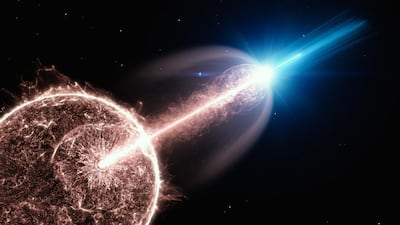Scientists have observed what they believe to be among the brightest explosions in the universe caused by the death of a star.
The collapsing star allowed them to observe the longest period of "gamma-ray afterglow" – an enormous radiation burst that is produced after a large star's core collapses and creates a black hole.
An artist's impression of the event portrays an epic burst of light shooting from the dying star.
It is additionally believed to be one of the nearest gamma-ray bursts observed so far, with a distance of about one billion light years away.
That is considered by scientists to be in Earth's "cosmic backyard" as previous ones have usually been 20 billion light years away.
The High Energy Stereoscopic System telescopes recorded the event in 2019, with findings now published in the Science journal.
Scientists are now challenging the idea of how X-rays and gamma rays are produced in stellar explosions through these observations.
"We were really sitting in the front row when this gamma-ray burst happened," said Dr Andrew Taylor, co-author of the study at Germany's Deutsches Elektronen-Synchrotron research centre.
"We could observe the afterglow for several days and to unprecedented gamma-ray energies.”
Nasa's Fermi and Swift satellites first detected a gamma-ray burst in the constellation of Eridanus.

X-rays from the burst were also detected by the Swift satellite in Earth's orbit. The very-high-energy gamma rays entered the atmosphere and caused air showers that were observed by the high energy telescopes on the ground in Namibia.
The telescopes also caught the explosion’s afterglow when it became visible.
The gamma-ray burst’s energy was measured at 3.3 tera-electronvolts – about trillion times as energetic as the photons of visible light.
Edna Ruiz-Velasco, another co-author, said the observations were significant because the afterglow was present for three days.
“This is what's so exceptional about this gamma-ray burst - it happened in our cosmic backyard where the very-high-energy photons were not absorbed in collisions with background light on their way to Earth, as it happens over larger distances in the cosmos,” she said.
The observations have challenged previous theories that say X-ray and very-high energy gamma-ray emission are produced from separate mechanisms. Scientists have now discovered similarities between the two after studying this recent burst’s afterglow.
Dmitry Khangulyan, another co-author, said: "It is rather unexpected to observe such remarkably similar spectral and temporal characteristics in the X-ray and very-high energy gamma-ray energy bands, if the emission in these two energy ranges had different origins.”








